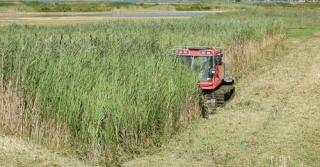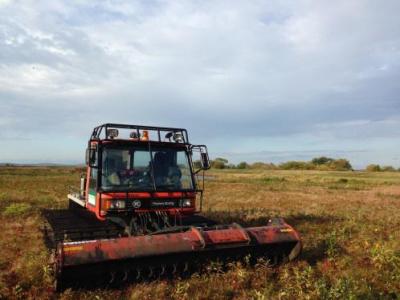Mowing Phragmites

Phragmites (Phragmites australis) is an invasive, aggressive wetland plant that out-competes native plants and displaces native animals. Phragmites leads to a variety of biological impacts. In the growing season, Phragmites has a distinctive purple-brown-silver plume that appears in summer. Plants can grow up to 18 feet in height; but the majority of the plant is below the ground, in a dense mass of roots and rhizomes. The dense stands covering the salt marsh limit access and create environments that promote the reproduction of mosquitos by reducing natural control methods. Eradicating these aggressive stands allows access for larvicide control as well as promotes natural control such as the introduction of fish and wildlife to previously inaccessible habitat.
Field technicians cut phragmites by means of customized PistenBully snow groomers, outfitted with a flail mower for use in the salt marsh. Phragmites can eliminate small intertidal channels and obliterate pool habitat that offers natural refuge and feeding grounds for invertebrates, fish and water birds. Decomposing phragmites can raise the surface elevation of the salt marsh more rapidly than would occur with native lower-growing vegetation. Higher elevations reduce saltwater flooding, depriving the marsh of vital nutrients and salinity needed by native salt marsh plants and animals. A higher and drier marsh leads to less vigorous growth of native salt marsh vegetation, allowing phragmites to gain a stronger foothold and continue its spread over the salt marsh. Allowing wildlife to return to their habitat creates the biological controls needed for a healthier ecosystem. For More Information on Phragmites, see the Fish and Wildlife Service Phragmites Fact Sheet.

